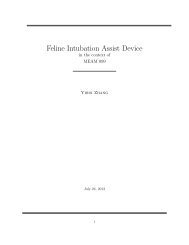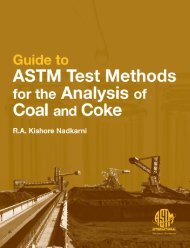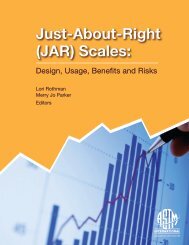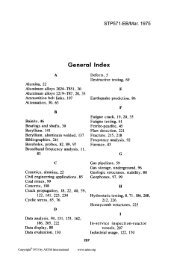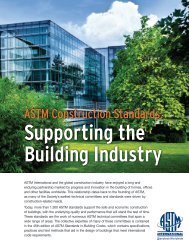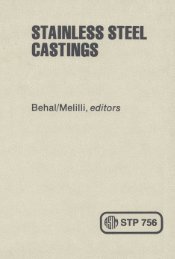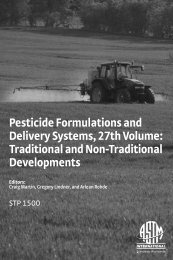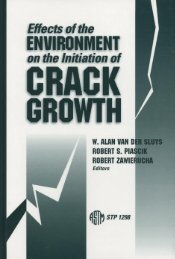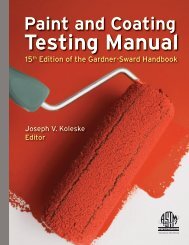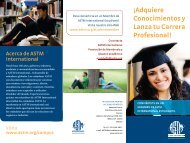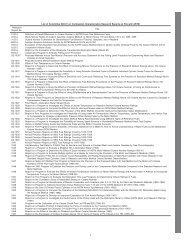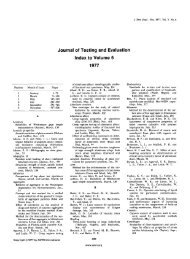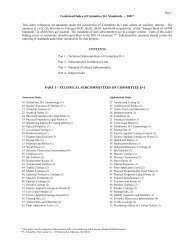Form and Style for ASTM Standards - ASTM International
Form and Style for ASTM Standards - ASTM International
Form and Style for ASTM Standards - ASTM International
Create successful ePaper yourself
Turn your PDF publications into a flip-book with our unique Google optimized e-Paper software.
PART C<br />
FORM OF OTHER TYPES OF <strong>ASTM</strong> STANDARDS<br />
INTRODUCTION<br />
In addition to test methods <strong>and</strong> specifications, <strong>ASTM</strong> st<strong>and</strong>ards take other <strong>for</strong>ms, including the<br />
following:<br />
Classifications<br />
Practices<br />
Guides<br />
Terminology or Definitions (see Part E)<br />
Reference Radiographs<br />
Reference Photographs<br />
Tables<br />
Charts<br />
As a committee attempts to develop a st<strong>and</strong>ard, the question of differentiation between a practice <strong>and</strong><br />
a guide may arise. In general, a practice underscores a general usage principle whereas a guide suggests<br />
an approach. A st<strong>and</strong>ard practice connotes accepted procedures <strong>for</strong> the per<strong>for</strong>mance of a given task.<br />
Refer to definitions given on p. vii. A guide may propose a series of options or instructions that offer<br />
direction without recommending a definite course of action. The purpose of this type of st<strong>and</strong>ard is to<br />
offer guidance based on a consensus of viewpoints but not to establish a st<strong>and</strong>ard practice to follow in all<br />
cases. A guide is intended to increase the awareness of the user concerning available techniques in a<br />
given subject area, while providing in<strong>for</strong>mation from which subsequent testing programs can be derived.<br />
Regarding reference radiographs, reference photographs, tables, <strong>and</strong> charts, there are relatively few<br />
subject headings, <strong>and</strong> the <strong>for</strong>m of the st<strong>and</strong>ard is left to the jurisdiction of the sponsoring committee. The<br />
first two types listed in the introduction to Part C, however, are most common <strong>and</strong> are given greater<br />
treatment below.<br />
Special instructions with respect to the legal aspects are included in Part F <strong>and</strong> shall be followed in<br />
writing any st<strong>and</strong>ard. These include such matters as contractual items, caveat statements, patents, <strong>and</strong> fire<br />
st<strong>and</strong>ards. Assistance on development of fire st<strong>and</strong>ards is available from Committee E05. The policies<br />
contained in Part F are approved by <strong>and</strong> are under the jurisdiction of the <strong>ASTM</strong> Board of Directors.<br />
When a st<strong>and</strong>ard is being developed, the costs associated with its development <strong>and</strong> subsequent use<br />
generally should be considered. The prime objective should be the optimum use of resources to achieve<br />
satisfactory definition of the product or service. However, it should be noted that when the st<strong>and</strong>ard<br />
relates to the safety of persons, cost considerations are likely to become much less important than when<br />
attributes of materials or products are involved. Some st<strong>and</strong>ards, such as a definition, impose no cost on<br />
the user; others that include numerous <strong>and</strong> extensive requirements can entail significant expense to users<br />
of the st<strong>and</strong>ard. The requirements to be included should, there<strong>for</strong>e, be those that are technically relevant<br />
<strong>and</strong> yield benefits commensurate with the cost of their determination.<br />
Cost effectiveness statements or rationale may be included within a st<strong>and</strong>ard if appropriate, usually<br />
in an appendix.<br />
C1. Description<br />
C1.1 “A classification is a systematic<br />
arrangement or division of materials, products,<br />
CLASSIFICATIONS<br />
C-1<br />
systems, or services into groups based on similar<br />
characteristics such as origin, composition, properties,<br />
or use.” 1<br />
1 From Regulations Governing <strong>ASTM</strong> Technical Committees.



